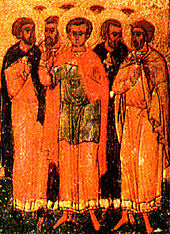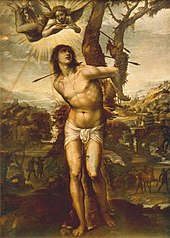
The reign of the emperor Diocletian (284−305) marked the final widespread persecution of Christians in the Roman Empire. The most intense period of violence came after Diocletian issued an edict in 303 more strictly enforcing adherence to the traditional religious practices of Rome in conjunction with the Imperial cult. Modern historians estimate that during this period, known as the Diocletianic or Great Persecution and extending several years beyond the reign of Diocletian, as many as 3,000−3,500 Christians were executed under the authority of Imperial edicts.
The church historian Eusebius, a Bishop of Caesarea who lived through both the "Little Peace" of the Church and the Great Persecution, is a major source for identifying Christian martyrs in this period. Martyr narratives flourished later as a genre of Christian literature, but are not contemporary with the persecutions and are often of dubious historicity. This article lists both historical and legendary figures traditionally identified as martyrs during the reign of Diocletian.
Martyrs of Palestine

Eusebius recorded many accounts of martyrdoms in Caesarea in his book The Martyrs of Palestine. Here are just a few of the names of martyrs as recorded by Eusebius in his work The Martyrs of Palestine:
- Procopius of Scythopolis, 7 July 303
- Timolaus and Companions, 303
- Alphaeus and Zacchaeus, 303 or 304
- Romanus of Caesarea, 303 or 304
- Aphian, 2 April 305
- Silvanus of Gaza, 311
Martyrs of Nicomedia
In his Church History, Eusebius discusses the martyrdoms at Nicomedia, naming two:
- Gorgonius of Nicomedia, 304
- Anthimus of Nicomedia, 304
Attested in early sources

- Shmona and Gurya, c. 297, as recorded in the Acts of Shmona and of Gurya (c. 309)
- Saint Sebastian, c. 288, first attested by Ambrose, bishop of Milan 374–397
- Euphemia, 303, attested in the Martyrologium Hieronymianum and the Fasti vindobonenses
- Felix and Adauctus, c. 303, attested in the works of Pope Gregory I (late 6th century) and in a miraculous martyrology by Ado in the 9th century that may have drawn on a 4th-century record by Pope Damasus I
- Agnes of Rome, c. 304, recorded by Ambrose
- Marcellinus and Peter, 304, first recorded by Damasus
Others


- Chrysanthus and Daria, according to the Martyrologium Hieronymianum
- Nicasius, Quirinus, Scubiculus, and Pientia, according to tradition
- Castulus and his wife Irene of Rome, according to tradition
- Mark and Marcellian, according to tradition
- Saint Tiburtius and Saint Susanna, according to legend
- Victor of Marseilles, according to tradition
- Pope Caius, according to legend
- Gabinus, died c. 300, according to tradition
- Sabinus of Spoleto, c. 300, according to tradition
- Anthony of Antioch, Celsus and Marcionilla, according to tradition
- Eulalia of Barcelona, 12 February 303, according to tradition
- Quirinus of Tegernsee, according to legend
- Engratia, 303, according to tradition
- George, 23 April 303, according to tradition
- Victor Maurus, c. 303, according to tradition
- Agathius, 8 May 303, according to tradition
- Erasmus of Formiae, c. 303, according to tradition
- Vitus, according to legend
- Cyriacus, according to tradition
- Alexander of Bergamo, according to legend
- Anastasius of Antioch, Julian and Basilissa, according to tradition
- Lucy, 304, according to tradition
- Vincent of Saragossa, c. 304, according to tradition
- Victoria of Albitina, c. 304, according to tradition
- Agape, Chionia, and Irene, 304, according to tradition
- Fidelis of Como, c. 304, according to tradition
- Saint Florian, c. 304, according to tradition
- Acisclus of Córdoba, 304, according to tradition
- Leocadia of Toledo, c. 304, according to tradition
- Quiricus and Julietta, 304, according to tradition
- Eulalia of Mérida, according to tradition
- Proculus of Pozzuoli, and Januarius, c. 305, according to tradition
- Vincent, Orontius, and Victor 305, according to tradition
- Chrysogonus, according to tradition
- Cantius, Cantianus, and Cantianilla, 304, reported by Maximus of Turin and Venantius Fortunatus
- Cessianus, 303
- Acacius of Sebaste, according to tradition
- Anastasia of Sirmium, according to tradition
- Archelais and Companions
- Philomena, according to tradition
- Pancras of Rome, according to tradition
- Verissimus, Maxima, and Julia, c. 303, first attested in the Martyrology of Usuard (8th century)
See also
Citations
- Frend, Martyrdom and Persecution, 393–94; Liebeschuetz, 251–52.
- Eusebius. "Martyrs of Palestine, long recension". Retrieved 7 May 2023.
- Harnack, Adolf (9 January 1997). The Expansion of Christianity in the First Three Centuries, 2 Volumes. Wipf and Stock Publishers. p. 262. ISBN 978-1-57910-002-5. Retrieved 18 February 2024.
References
- Frend, William H.C. Martyrdom and persecution in the early church: a study of a conflict from the Maccabees to Donatus. New York University Press, 1967. Reissued in 2008 by James Clarke Company, U.K. ISBN 0-227-17229-9
- Liebeschuetz, J. H. W. G. Continuity and Change in Roman Religion. Oxford: Oxford University Press, 1979. ISBN 0-19-814822-4